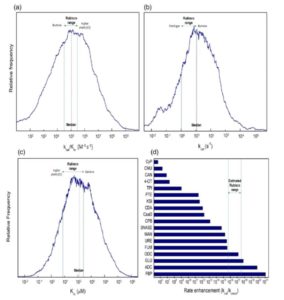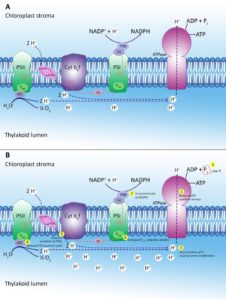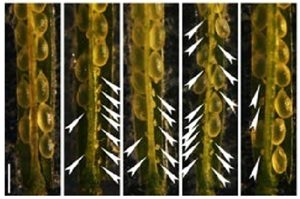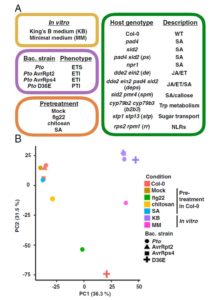What We’re Reading: March 30th
Commentary. 10KP: A phylodiverse genome sequencing plan
 Nobody doubts the great insights we have gained about plant diversity and evolution from genome sequencing, but the patchy nature of available genomes within the plant phylogeny remains a problem. Cheng et al. describe the 10KP (10,000 Plants) Genome Sequencing Project, which aims to sequence genomes from every major clade of plants (and protists) within five years, including seed plants from at least 8000 genera and 1000 nonseed plant genera. This Commentary sets out the goals and strategies of this ambitious and exciting project. (Summary by Mary Williams) GigaScience 10.1093/gigascience/giy013
Nobody doubts the great insights we have gained about plant diversity and evolution from genome sequencing, but the patchy nature of available genomes within the plant phylogeny remains a problem. Cheng et al. describe the 10KP (10,000 Plants) Genome Sequencing Project, which aims to sequence genomes from every major clade of plants (and protists) within five years, including seed plants from at least 8000 genera and 1000 nonseed plant genera. This Commentary sets out the goals and strategies of this ambitious and exciting project. (Summary by Mary Williams) GigaScience 10.1093/gigascience/giy013
Review: Rubisco is not really so bad ($)
 The carbon-fixing enzyme Rubisco (Ribulose‐1,5‐bisphosphate carboxylase/oxygenase) is much-maligned and has been described as “sluggish” and with “confused specificity”. In this new Review, Bathellier et al. argue that it is “not really so bad”. Their reasoning is that when Rubisco’s catalytic properties are compared to enzymes with related catalytic activities and in relevant physiological conditions, it really doesn’t stand out as a particularly slow or non-specific enzyme. The authors speculate that perhaps there is not as much to be gained from engineering a more efficient enzyme as previously thought. Nevertheless, there is still much to be learned by further research into this most important enzyme. (Summary by Mary Williams) Plant Cell Environ. 10.1111/pce.13149
The carbon-fixing enzyme Rubisco (Ribulose‐1,5‐bisphosphate carboxylase/oxygenase) is much-maligned and has been described as “sluggish” and with “confused specificity”. In this new Review, Bathellier et al. argue that it is “not really so bad”. Their reasoning is that when Rubisco’s catalytic properties are compared to enzymes with related catalytic activities and in relevant physiological conditions, it really doesn’t stand out as a particularly slow or non-specific enzyme. The authors speculate that perhaps there is not as much to be gained from engineering a more efficient enzyme as previously thought. Nevertheless, there is still much to be learned by further research into this most important enzyme. (Summary by Mary Williams) Plant Cell Environ. 10.1111/pce.13149
Red algal Rubisco fails to accumulate in transplastomic tobacco expressing Griffithsia monilis RbcL and RbcS genes
 Following up on earlier studies in which they introduced cyanobacterial Rubisco into tobacco, Lin and Hanson endeavoured to introduce into tobacco Rubisco genes from a red alga, which has an unusually high CO2/O2 specificity. Although they were able to demonstrate the presence of the genes and their transcription, the enzyme failed to accumulate, suggesting a need for additional factors for this Rubisco to assemble. This paper is an example of the importance of publishing sound (but perhaps disappointing) results, as these data will be useful for others trying to express distantly-related Rubiscos in plants. (Summary by Mary Williams) Plant Direct 10.1002/pld3.45
Following up on earlier studies in which they introduced cyanobacterial Rubisco into tobacco, Lin and Hanson endeavoured to introduce into tobacco Rubisco genes from a red alga, which has an unusually high CO2/O2 specificity. Although they were able to demonstrate the presence of the genes and their transcription, the enzyme failed to accumulate, suggesting a need for additional factors for this Rubisco to assemble. This paper is an example of the importance of publishing sound (but perhaps disappointing) results, as these data will be useful for others trying to express distantly-related Rubiscos in plants. (Summary by Mary Williams) Plant Direct 10.1002/pld3.45
The impacts of phosphorus deficiency on the photosynthetic electron transport chain
 Phosphorus deficiency is widespread and can severely limit plant growth. Carstensen et al. investigated how P deficiency affects photosynthesis in barley. They compared chlorophyll a fluorescence transients (OJIP transients) between P-deficient, sufficient and resupplied plants. They observed depletion in the I-step associated with P deficiency, which is consistent with an inhibition of electron transport to PSI. Interestingly, infiltration of these leaves with a solution containing Pi led to a recovery of the I-step within an hour. Further, they showed that Pi deficiency led to a decrease in ATP production, leading to acidification of the thylakoid lumen, leading to energy dissipation via non-photochemical quenching and restricted PQH2 oxidation due to the proton backlog caused by lumen acidification. (Summary by Mary Williams) Plant Physiol. 10.1104/pp.17.01624
Phosphorus deficiency is widespread and can severely limit plant growth. Carstensen et al. investigated how P deficiency affects photosynthesis in barley. They compared chlorophyll a fluorescence transients (OJIP transients) between P-deficient, sufficient and resupplied plants. They observed depletion in the I-step associated with P deficiency, which is consistent with an inhibition of electron transport to PSI. Interestingly, infiltration of these leaves with a solution containing Pi led to a recovery of the I-step within an hour. Further, they showed that Pi deficiency led to a decrease in ATP production, leading to acidification of the thylakoid lumen, leading to energy dissipation via non-photochemical quenching and restricted PQH2 oxidation due to the proton backlog caused by lumen acidification. (Summary by Mary Williams) Plant Physiol. 10.1104/pp.17.01624
Iron availability sensed in leaf vasculature causes changes in transcriptional programs
 Iron is an essential micronutrient for plants but it is often not bioavailable in the soil. Thus, plants have evolved difference processes for iron sensing and iron uptake. OLIGOPEPTIDE TRANSPORTER 3 (OPT3) is an important iron transporter and is a component of the systemic network that mediates iron deficiency responses in Arabidopsis. This study by Khan and colleagues use expression analysis, transcription analysis and analysis of OPT3 mutants to examine iron sensing in the roots and shoots. They describe early transcriptional events related to iron limitation and resupply, and show that the leaf vasculature responds faster than the roots to changes in iron supply. These results indicate that OPT3 and the leaf vasculature have roles in iron sensing between the root and the shoot. (Summary by Julia Miller) Plant Cell Environ. 10.1111/pce.13192
Iron is an essential micronutrient for plants but it is often not bioavailable in the soil. Thus, plants have evolved difference processes for iron sensing and iron uptake. OLIGOPEPTIDE TRANSPORTER 3 (OPT3) is an important iron transporter and is a component of the systemic network that mediates iron deficiency responses in Arabidopsis. This study by Khan and colleagues use expression analysis, transcription analysis and analysis of OPT3 mutants to examine iron sensing in the roots and shoots. They describe early transcriptional events related to iron limitation and resupply, and show that the leaf vasculature responds faster than the roots to changes in iron supply. These results indicate that OPT3 and the leaf vasculature have roles in iron sensing between the root and the shoot. (Summary by Julia Miller) Plant Cell Environ. 10.1111/pce.13192
The ADAPTOR PROTEIN-3 complex mediates pollen tube growth by coordinating vacuolar targeting and organization
 Adaptor proteins (AP) are involved in sorting proteins and are able to recognize cargo and coat proteins during vesicle formation. AP-3 specifically targets protein cargoes to vacuoles. Feng et al. investigate the role of AP-3 in plant reproduction. ap-3 mutants have reduced seed set that is characterized by unfertilized ovules predominately at the bottom of siliques, owing to the inability of pollen tubes to grow that far down the pistil. Vacuolar organization was also compromised in these mutants, as seen by less extensive vacuolar reach and decreased complexity. The authors further confirm mislocalization of a tonoplast localized protein (PAT10) and its subsequently associated proteins (CBL2 and CBL3). Finally, ap-3 mutants exhibited reduced calcium levels at the pollen tube tip and this was found to contribute significantly to the reduction in pollen tube growth. This paper highlights the importance of several proteins in maintain pollen tube growth and adds to the mechanism of how calcium-gradients are sustained at the pollen tube tip. (Summary by Alecia Biel) Plant Physiol. 10.1104/pp.1701722.
Adaptor proteins (AP) are involved in sorting proteins and are able to recognize cargo and coat proteins during vesicle formation. AP-3 specifically targets protein cargoes to vacuoles. Feng et al. investigate the role of AP-3 in plant reproduction. ap-3 mutants have reduced seed set that is characterized by unfertilized ovules predominately at the bottom of siliques, owing to the inability of pollen tubes to grow that far down the pistil. Vacuolar organization was also compromised in these mutants, as seen by less extensive vacuolar reach and decreased complexity. The authors further confirm mislocalization of a tonoplast localized protein (PAT10) and its subsequently associated proteins (CBL2 and CBL3). Finally, ap-3 mutants exhibited reduced calcium levels at the pollen tube tip and this was found to contribute significantly to the reduction in pollen tube growth. This paper highlights the importance of several proteins in maintain pollen tube growth and adds to the mechanism of how calcium-gradients are sustained at the pollen tube tip. (Summary by Alecia Biel) Plant Physiol. 10.1104/pp.1701722.
Polyamines regulate strawberry fruit ripening by abscisic acid, auxin, and ethylene
 Polyamines, which include putrescine [NH2(CH2)4NH2], spermidine [NH2(CH2)4NH(CH2)3NH2], and spermine [NH2(CH2)3NH(CH2)4NH(CH2)3NH2], are widespread in nature. Although their mechanisms of action remain largely unresolved, they have demonstrated roles in plants ranging from abiotic stress tolerance to fruit ripening. Guo, Wang et al. examined the contributions of polyamines to strawberry fruit ripening. They showed that spermidine levels increase during ripening, and that exogenous application of spermidine or spermine accelerates ripening. Altering polyamine levels by alterine the expression of a biosynthetic enzyme had the corresponding effect, largely mediated through other hormones. (Summary by Mary Williams) Plant Physiol. 10.1104/pp.18.00245
Polyamines, which include putrescine [NH2(CH2)4NH2], spermidine [NH2(CH2)4NH(CH2)3NH2], and spermine [NH2(CH2)3NH(CH2)4NH(CH2)3NH2], are widespread in nature. Although their mechanisms of action remain largely unresolved, they have demonstrated roles in plants ranging from abiotic stress tolerance to fruit ripening. Guo, Wang et al. examined the contributions of polyamines to strawberry fruit ripening. They showed that spermidine levels increase during ripening, and that exogenous application of spermidine or spermine accelerates ripening. Altering polyamine levels by alterine the expression of a biosynthetic enzyme had the corresponding effect, largely mediated through other hormones. (Summary by Mary Williams) Plant Physiol. 10.1104/pp.18.00245
Receptor-like cytoplasmic kinase STRK1 mediates salt tolerance in rice via H2O2 homeostasis ($)
 Salinity is a widespread stressor. Zhou et al. investigated the role of receptor-like kinases (RLKs) in salinity tolerance by identifying RLKs that are transcriptionally upregulated by salt treatment. Candidates were introduced either as overexpression (full-length) or dominant negative (partial) clones, leading to the identification of STRK1 (salt tolerance receptor-like cytoplasmic kinase 1) as a conferring salt-tolerance. STRK1 is a cytoplasmic kinase that is anchored to the plasma membrane by palmitoyl anchors (covalently linked fatty acids). Through a yeast two-hybrid study, the authors showed that STRK1 interacts with catalase, which it regulates through phosphorylation, which in turn confers tolerance to the oxidative stress that results from salt stress. Finally, the authors showed that overexpressing STRK1 improves grain yield under salt stress. (Summary by Mary Williams) Plant Cell 10.1105/tpc.17.01000
Salinity is a widespread stressor. Zhou et al. investigated the role of receptor-like kinases (RLKs) in salinity tolerance by identifying RLKs that are transcriptionally upregulated by salt treatment. Candidates were introduced either as overexpression (full-length) or dominant negative (partial) clones, leading to the identification of STRK1 (salt tolerance receptor-like cytoplasmic kinase 1) as a conferring salt-tolerance. STRK1 is a cytoplasmic kinase that is anchored to the plasma membrane by palmitoyl anchors (covalently linked fatty acids). Through a yeast two-hybrid study, the authors showed that STRK1 interacts with catalase, which it regulates through phosphorylation, which in turn confers tolerance to the oxidative stress that results from salt stress. Finally, the authors showed that overexpressing STRK1 improves grain yield under salt stress. (Summary by Mary Williams) Plant Cell 10.1105/tpc.17.01000
Transcriptome landscape of a bacterial pathogen under plant immunity
 Many studies have examined how plants respond transcriptionally to pathogen attack. This study investigates how a bacterial pathogen [Pseudomonas syringae pv. tomato DC3000 (Pto)] alters its transcriptome very early in the infection process. To accomplish this, Nobori et al. developed two methods to enrich for rare bacterial transcripts against a much larger number of plant transcripts; in the first they isolated bacterial cells from infected plants prior to RNA isolation, and in the second they used a more expensive method involving removal of abundant plant RNAs with customized probes. Interestingly, these two methods led to very similar results. The authors looked at a single time point (6 hours post infection) but in a total of 27 combinations of plant and bacterial genotypes (including both plant and bacterial mutants affecting virulence or defense). In addition to generating rich data resources, this study also revealed some unexpected findings such as the possibility that the host manipulates the pathogen’s perception of iron as an antibacterial strategy. (Summary by Mary Williams) Proc. Natl. Acad. Sci. USA 10.1073/pnas.1800529115
Many studies have examined how plants respond transcriptionally to pathogen attack. This study investigates how a bacterial pathogen [Pseudomonas syringae pv. tomato DC3000 (Pto)] alters its transcriptome very early in the infection process. To accomplish this, Nobori et al. developed two methods to enrich for rare bacterial transcripts against a much larger number of plant transcripts; in the first they isolated bacterial cells from infected plants prior to RNA isolation, and in the second they used a more expensive method involving removal of abundant plant RNAs with customized probes. Interestingly, these two methods led to very similar results. The authors looked at a single time point (6 hours post infection) but in a total of 27 combinations of plant and bacterial genotypes (including both plant and bacterial mutants affecting virulence or defense). In addition to generating rich data resources, this study also revealed some unexpected findings such as the possibility that the host manipulates the pathogen’s perception of iron as an antibacterial strategy. (Summary by Mary Williams) Proc. Natl. Acad. Sci. USA 10.1073/pnas.1800529115
Crosstalk between PTGS and TGS pathways in natural antiviral immunity and disease recovery
 Viruses are significant pathogens of plants, and we know that plants defend themselves in part through the production of small RNAs (sRNAs) that suppress the virus. The viral pathogens in turn can produce viral supressors of RNA silencing (VSR). Kørner et al. investigated the role of gene silencing (post-trancriptional PTGS and transcriptional TGS) in the recovery of Arabidopsis plants from infection by oilseed rape mosaic virus (ORMV). They took advantage of Arabidopsis mutants blocked in various aspects of gene silencing, and examined viral RNA as well as host and viral-derived sRNAs. Although leaves produced later after infection carry the virus, they remain asymptomatic. The authors suggest a model in which “recovery reflects the establishment of a tolerant state in infected tissues and occurs following robust delivery of antiviral secondary siRNAs from source to sink tissues, and establishment of a dosage able to block the VSR activity involved in the formation of disease symptoms.” (Summary by Mary Williams) Nature Plants 10.1038/s41477-018-0117-x
Viruses are significant pathogens of plants, and we know that plants defend themselves in part through the production of small RNAs (sRNAs) that suppress the virus. The viral pathogens in turn can produce viral supressors of RNA silencing (VSR). Kørner et al. investigated the role of gene silencing (post-trancriptional PTGS and transcriptional TGS) in the recovery of Arabidopsis plants from infection by oilseed rape mosaic virus (ORMV). They took advantage of Arabidopsis mutants blocked in various aspects of gene silencing, and examined viral RNA as well as host and viral-derived sRNAs. Although leaves produced later after infection carry the virus, they remain asymptomatic. The authors suggest a model in which “recovery reflects the establishment of a tolerant state in infected tissues and occurs following robust delivery of antiviral secondary siRNAs from source to sink tissues, and establishment of a dosage able to block the VSR activity involved in the formation of disease symptoms.” (Summary by Mary Williams) Nature Plants 10.1038/s41477-018-0117-x
Pursuing sustainable productivity with millions of smallholder farmers ($)
 Improving crop productivity of rural areas while addressing pollution problems is a challenge that not only depends on scientific studies and technology but also requires an effective dialog with the smallholder farming communities. This month, Nature published the results of a ten-year Chinese agricultural program that involved 1,152 scientists and graduate students, thousands of agricultural specialists and 20.9 million farmers. The program was structured in three phases: 1) field trials across several Chinese agroecological zones in order to establish guidelines of integrated soil–crop system management (ISSM) for rice, wheat and maize; 2) engagement of the local farmers for a 10-year trial (2005-2015); 3) collection and evaluation of the results. Point 2 included, among others: workshops, distribution of high quality seeds and fertilizers and the active participation of the local farmers in the implementation of the recommended agricultural improvements. The collected data showed an average yield increase of around 11%, around 15% reduction in the use of fertilizers and a 7.7% reduction in CO2 production in comparison to areas not involved in the study. (Summary by Elisa Dell’Aglio) Nature 10.1038/nature25785
Improving crop productivity of rural areas while addressing pollution problems is a challenge that not only depends on scientific studies and technology but also requires an effective dialog with the smallholder farming communities. This month, Nature published the results of a ten-year Chinese agricultural program that involved 1,152 scientists and graduate students, thousands of agricultural specialists and 20.9 million farmers. The program was structured in three phases: 1) field trials across several Chinese agroecological zones in order to establish guidelines of integrated soil–crop system management (ISSM) for rice, wheat and maize; 2) engagement of the local farmers for a 10-year trial (2005-2015); 3) collection and evaluation of the results. Point 2 included, among others: workshops, distribution of high quality seeds and fertilizers and the active participation of the local farmers in the implementation of the recommended agricultural improvements. The collected data showed an average yield increase of around 11%, around 15% reduction in the use of fertilizers and a 7.7% reduction in CO2 production in comparison to areas not involved in the study. (Summary by Elisa Dell’Aglio) Nature 10.1038/nature25785



